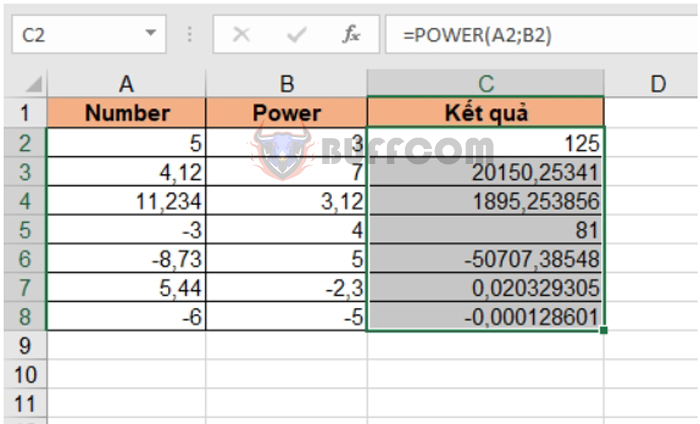Mastering Exponents in Excel: Power Functions Explained

Mastering exponents in Excel can significantly enhance your data manipulation and analysis capabilities. This guide will delve into the world of power functions, providing insights and practical examples on how to effectively use them within Excel spreadsheets. Whether you're calculating compound interest, predicting growth patterns, or simply trying to understand exponential growth, Excel's functions can simplify these tasks.
Understanding the Basics of Exponents

Before we dive into Excel, let’s recap the fundamental principles of exponents:
- Power or Exponential Form:
a^nwhereais the base andnis the exponent or power. - Rules of Exponents:
a^m * a^n = a^(m+n)a^m / a^n = a^(m-n)(a^m)^n = a^(m*n)a^0 = 1(for anya ≠ 0)a^1 = a
Excel’s Power Functions

Excel offers several functions to handle exponents:
POWER: Calculates the result of a number raised to a power.^Operator: Similar to the POWER function but more straightforward in formula construction.EXP: Calculatese^x, whereeis Euler’s number (approximately 2.71828).LOG: Calculates the logarithm of a number with an optional base, which can be used in inverse exponentiation.
How to Use Excel Functions for Exponential Calculations

The POWER Function

Let’s see how to use the POWER function:
- Formula Syntax:
=POWER(number, power) - Example: To calculate 5 raised to the power of 3, you’d use
=POWER(5, 3)which returns 125.
The “^” Operator

Alternatively, you can use the “^” operator:
- Example: To find 2 raised to the power of 4, simply type
=2^4, yielding 16.
Using the EXP Function

The EXP function calculates e to the power of the number specified:
- Formula Syntax:
=EXP(number) - Example: To find
eto the power of 2, you would use=EXP(2), which returns approximately 7.389.
Implementing LOG for Inverse Exponentiation

The LOG function can be employed for finding inverse exponents:
- Formula Syntax:
=LOG(number, [base]) - Example: To find the power 8 must be raised to to reach 64 (which is 2), use
=LOG(64, 8), returning 2.
📝 Note: Remember that Excel uses the '^' operator as a superscript for visual representation of exponents, not for calculation.
Practical Applications

Compound Interest

Exponents are particularly useful in financial calculations like compound interest:
- Formula:
A = P * (1 + r/n)^(n*t) - Where:
A= Future ValueP= Principalr= Annual Interest Raten= Number of Times Interest is Compounded per Yeart= Time in Years
Example: To calculate the future value of 1000 with an annual interest rate of 5% compounded quarterly for 5 years, you would use the formula:</p> <pre><code>=1000 * (1 + 0.05/4)^(4*5)</code></pre> <p>Which would return approximately 1,283.36.
Growth Rate Calculations

Exponents are also used to model exponential growth or decay:
- Example: If a population grows by 2% each year, to predict the population after 10 years, you would use:
=Initial Population * (1 + 0.02)^10📝 Note: Ensure that you have the correct cell references in your formulas to avoid calculation errors.
Key Takeaways

Understanding and using exponents in Excel can revolutionize how you analyze data, project growth, or solve financial problems. Here are some key points:
- Excel provides multiple functions to handle exponents including
POWER, the “^” operator,EXP, andLOG. - Exponents are foundational for calculating compound interest, predicting growth rates, and more.
- Accurate data input and formula construction are critical for achieving correct results.
To ensure you're maximizing the potential of Excel's power functions, remember to:
- Always double-check your formulas for correct application of rules.
- Use the
LOGfunction for inverse exponentiation to reverse exponent operations. - Understand the context in which you're using exponents to avoid miscalculations or misinterpretations.
By mastering exponents in Excel, you've unlocked the ability to perform advanced data analysis and financial modeling with ease. This knowledge not only allows for quick computations but also provides insights into the mathematics behind exponential functions, offering a deeper understanding of how they relate to the real world.
How do I use the POWER function in Excel?

+
To use the POWER function, enter =POWER(number, power) into your formula, where ‘number’ is the base and ‘power’ is the exponent.
What does the EXP function do in Excel?

+
The EXP function computes Euler’s number ‘e’ raised to the power of a given number. The syntax is =EXP(number).
Can I use the ^ operator for exponents in Excel?

+
Yes, the “^” operator is shorthand for raising a number to a power. For example, =2^3 is equivalent to =POWER(2, 3).
What is the difference between LOG and LN in Excel?

+
The LOG function calculates the logarithm of a number with a specified base or the default base of 10. LN computes the natural logarithm (base ‘e’) of a number.
How do I reverse exponentiation in Excel?
+You can use the LOG function to reverse exponentiation. If you have y = a^x and want to find ‘x’, use =LOG(y, a).



